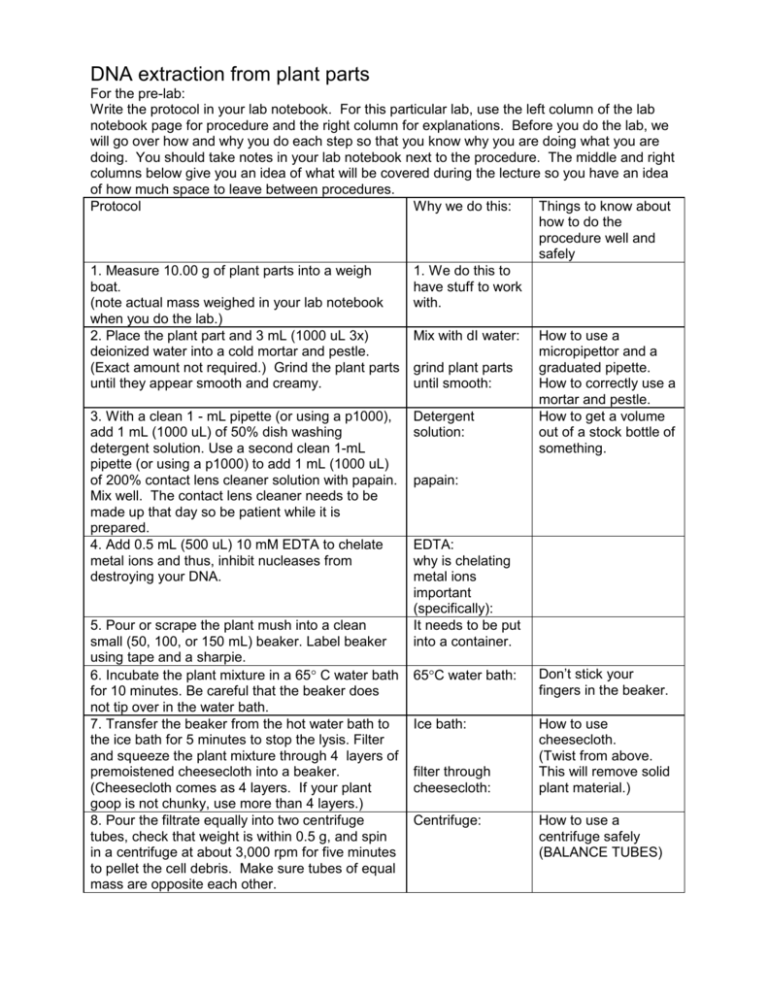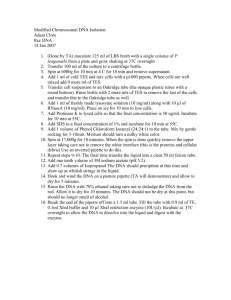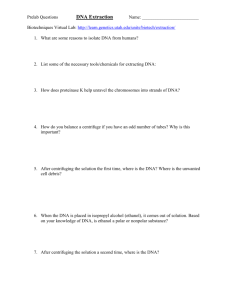Semi-Quick DNA extraction from Spinach
advertisement

DNA extraction from plant parts For the pre-lab: Write the protocol in your lab notebook. For this particular lab, use the left column of the lab notebook page for procedure and the right column for explanations. Before you do the lab, we will go over how and why you do each step so that you know why you are doing what you are doing. You should take notes in your lab notebook next to the procedure. The middle and right columns below give you an idea of what will be covered during the lecture so you have an idea of how much space to leave between procedures. Protocol Why we do this: Things to know about how to do the procedure well and safely 1. Measure 10.00 g of plant parts into a weigh 1. We do this to boat. have stuff to work (note actual mass weighed in your lab notebook with. when you do the lab.) 2. Place the plant part and 3 mL (1000 uL 3x) Mix with dI water: How to use a deionized water into a cold mortar and pestle. micropipettor and a (Exact amount not required.) Grind the plant parts grind plant parts graduated pipette. until they appear smooth and creamy. until smooth: How to correctly use a mortar and pestle. 3. With a clean 1 - mL pipette (or using a p1000), Detergent How to get a volume add 1 mL (1000 uL) of 50% dish washing solution: out of a stock bottle of detergent solution. Use a second clean 1-mL something. pipette (or using a p1000) to add 1 mL (1000 uL) of 200% contact lens cleaner solution with papain. papain: Mix well. The contact lens cleaner needs to be made up that day so be patient while it is prepared. 4. Add 0.5 mL (500 uL) 10 mM EDTA to chelate EDTA: metal ions and thus, inhibit nucleases from why is chelating destroying your DNA. metal ions important (specifically): 5. Pour or scrape the plant mush into a clean It needs to be put small (50, 100, or 150 mL) beaker. Label beaker into a container. using tape and a sharpie. Don’t stick your 6. Incubate the plant mixture in a 65 C water bath 65C water bath: fingers in the beaker. for 10 minutes. Be careful that the beaker does not tip over in the water bath. 7. Transfer the beaker from the hot water bath to Ice bath: How to use the ice bath for 5 minutes to stop the lysis. Filter cheesecloth. and squeeze the plant mixture through 4 layers of (Twist from above. premoistened cheesecloth into a beaker. filter through This will remove solid (Cheesecloth comes as 4 layers. If your plant cheesecloth: plant material.) goop is not chunky, use more than 4 layers.) 8. Pour the filtrate equally into two centrifuge Centrifuge: How to use a tubes, check that weight is within 0.5 g, and spin centrifuge safely in a centrifuge at about 3,000 rpm for five minutes (BALANCE TUBES) to pellet the cell debris. Make sure tubes of equal mass are opposite each other. 9. Pour the supernatant into a clean plastic tube. Slowly pipette or pour 1.5x volume of ice-cold 95% ethanol carefully down the side of the tube so that there are two phases. Do not shake. 10. Let sit undisturbed for 10-15 minutes on ice, if possible. As you watch, air bubbles and cream-colored fibers of DNA should rise slowly to the interface. If the yield of DNA is really high, the DNA fibers may form a mat that will rise into the ethanol. At this point we’ll leave the tubes in the refrigerator so that the DNA can go into the ethanol solution overnight. 11. Either hook the DNA at the interface with the hooked Pasteur pipette or spool the DNA onto a pipette or glass rod by moving the hook slowly through the two liquid phases at the alcohol extract interface using a circular motion. Carefully, put the DNA into a 1.5 mL tube by scraping it off the glass rod against the lip of the tube. 12. If you are unable to get the DNA to spool, use a plastic transfer pipette to transfer the DNA at the interface to a 1.5-mL microcentrifuge tube. Spin in a microcentrifuge for 5 to10 minutes to pellet the DNA. 13. Remove as much alcohol as possible from the DNA with a micropipette or transfer pipette. It is important to allow the DNA pellet to dry. If the DNA has been spun, excess ethanol can be drained off by inverting the tube on a paper towel for a few minutes and allowing it to drain. The remaining traces of ethanol can be evaporated by leaving the tube open and incubating it at 37C for 5 to 10 minutes. Allow the DNA to dry until the pellet has the appearance of powder or cloudy cellophane. The actual appearance of the DNA will depend upon how pure the sample is. DNA that is fairly pure will look like cloudy cellophane. 14. Add approximately 0.5 mL TE buffer to resuspend the pellet. Use a vortex mixer or flick the tube to mix well. A pipette may be used to resuspend the DNA by pipetting up and down to dissolve the DNA pellet. It may take several minutes to solubilize the DNA. Storing DNA frozen at -20C and then thawing the DNA often helps solubilize it. Adding equal volumes of 95% ethanol: How to pour into a new tube. How to pour so that layers don’t mix. Why does the DNA precipitate in the ethanol solution? We hook the DNA to remove the DNA from the rest of the junk. How to get a 1.5 mL tube out of the sterile beaker. Balance the tubes. Why does all of the ethanol need to be removed from the DNA? What is TE buffer? Why is TE buffer used?








